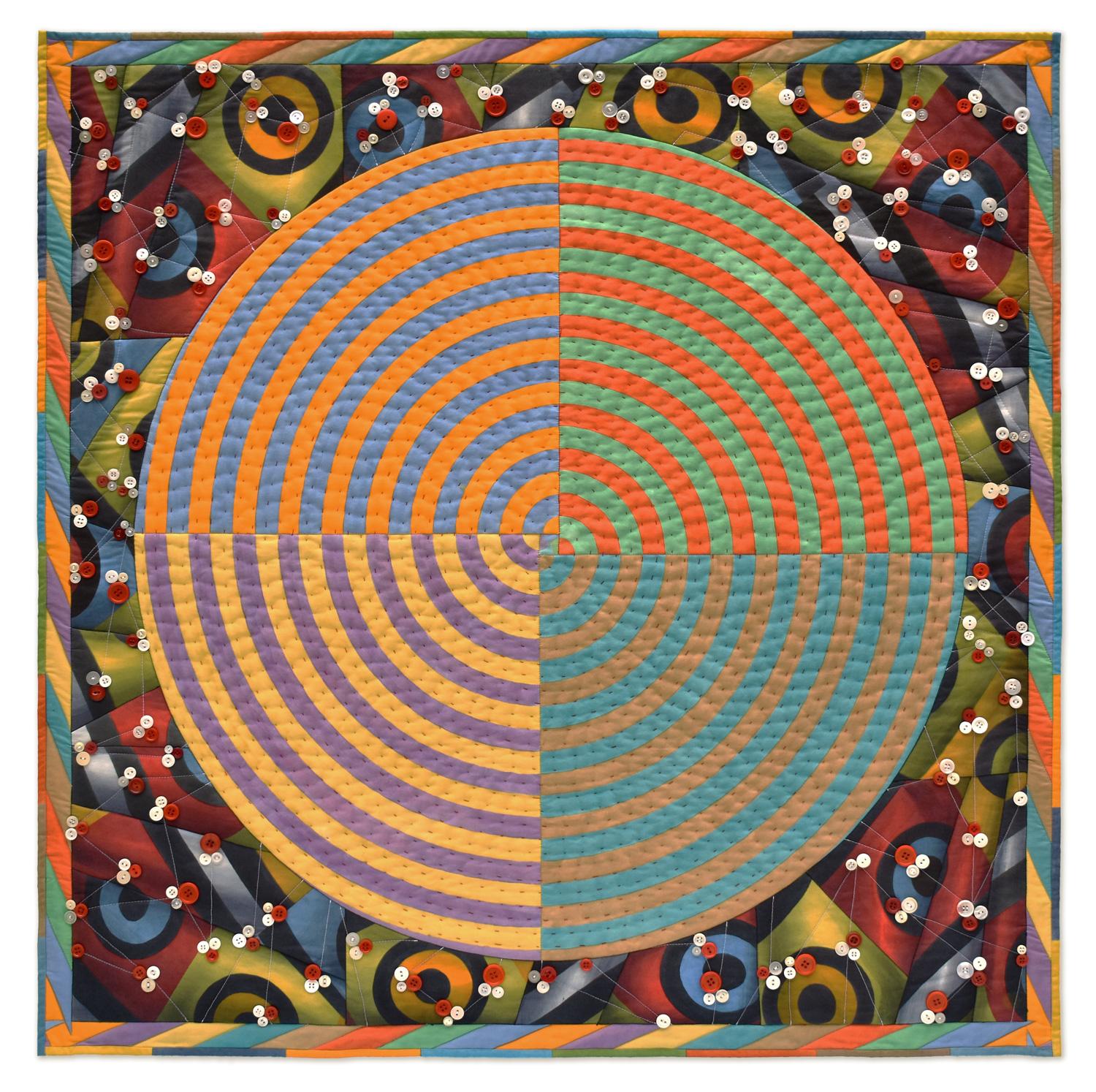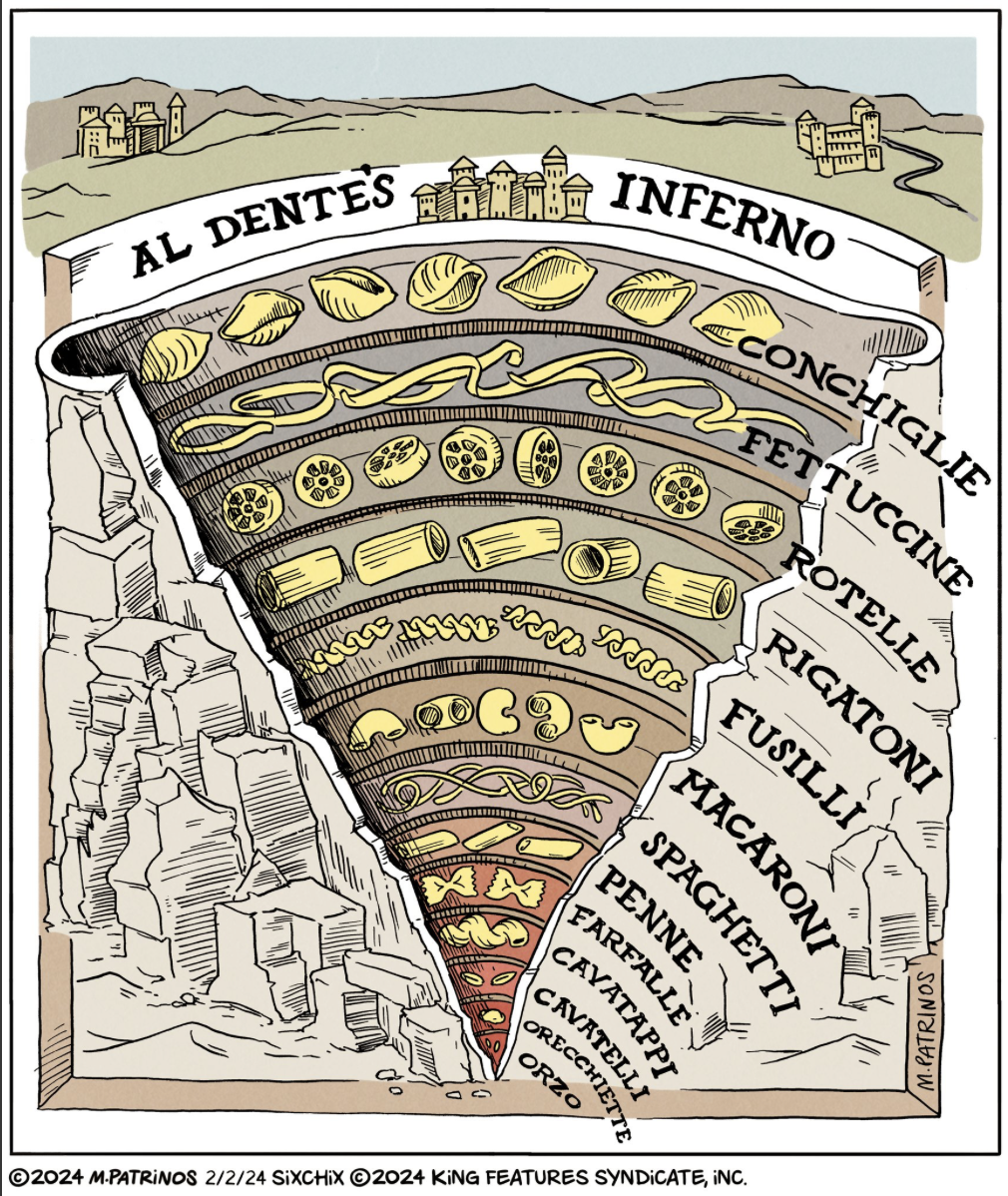Artists Gayle Fraas and Duncan Slade utilized machine and hand stitching techniques to create the above out of dye painted cotton and antique buttons. —Gayle Fraas and Duncan Slade, “Circle of Hell, why not?” Studio Art Quilt Associates, 2020 (retrieved March 20, 2024)
“Al Dente’s Inferno“
Social media comic illustrator Maritsa Patrinos (@maritsapatrinos) parodies Dante’s nine circles from Inferno as various types of pasta. —Maritsa Patrinos, SixChix ©2024 King Features Syndicate, inc., February 2, 2024 (retrieved February 7, 2024)
Contributed by Casey Kozan, Virginia Polytechnic Institute and State University ’25
Maurice Pefura, The Silent Way (2013)

“The spectator is invited to enter, to move through this bright, white virginal structure and to slowly discover that on the surface of the sheets, printed in white on white, there are lines taken from the Cantos that make up Dante’s Paradiso. The ensemble of the elements is illuminated by a soft, pure light that serves as a guide: the transformation that the artist wishes to bring about does not focus on the path followed by Dante, but rather on the perennial and memorable presence of Beatrice, who according to the artist embodies the very sense of Dante’s Paradiso. The installation thus becomes a path on which the onlooker is enshrouded in words and light. A place where—just like in the Comedy itself—it is still possible to enter and be illuminated by the candour and potency of the very essence of love.”
From The Divine Comedy: Heaven, Purgatory, and Hell Revisited by Contemporary African Artists by Simon Njami.
See also the images in Griot magazine, which describes the piece as it was presented in Njami’s I is An Other / Be the Other exhibit at the Galleria Nazionale di Arte Moderna e Contemporanea (GNAM) in Rome: “Maurice Prefura’s The Silent Way stages La Divina Commedia, a sort of labyrinth made of white floating empty pages that form its walls and hold visitors prisoners. Crossing this labyrinth, however, one realizes that there are visible inscriptions on the pages which can only be seen from certain angles, ‘as if in a rite of initiation.’ Once out of the labyrinth, one meets Beatrice.” –Johanne Affricot, “Contemporary Art and Africa in Rome,” Griot (March 20, 2018)
Ndary Lo, The Day After (2012)

“I see the world we are living in as both Hell and Purgatory. Our only hope in this life of ours, all that we have left is to try our best to be admitted to heaven someday. The Day After is an installation in which, after walking a long way through a dense and dark forest, one reaches that space where everything seems to be suspended, where one can feel this particular tension that we experience before embarking on a journey of which we don’t really know the name. The place is organized in a materialized circle and inhabited by iron characters which are ready to take off. The circle, in fact a spiral, symbolizes the energy of human beings, who find themselves in a new configuration, and they feel disoriented and experience a feeling of unreality.”
From The Divine Comedy: Heaven, Purgatory, and Hell Revisited by Contemporary African Artists by Simon Njami.
Read more about Senegalese sculptor Ndary Lô, see Wikipedia.fr.
Hadestown Musical – Music, Lyrics, and Book by Anaïs Mitchell (2019)
“The musical Hadestown (music, lyrics, and book by Anaïs Mitchell) brings a new take on the Greek myth of Orpheus and Eurydice. Much like Dante in the Inferno, the characters of Orpheus in Hadestown travel through an inferno-like factory run by Hades, the god of the underworld. Although the tragic hero Orpheus is mentioned in Canto IV of Dante’s Inferno, the similarities between the Divine Comedy and Hadestown do not stop there.” –Contributor Ava Buchanan
A notable link between the musical and the Inferno is the staging of the piece, which relies heavily on circular motion to move the plot forward (a common motif employed by Dante). Furthermore, the character of Hermes within the musical acts as a Virgil-like guide for Orpheus with the added omnipresent, post-narrative knowledge of Dante “the Poet”.
As a side note, the official Hadestown website notes that it is a “haunting and hopeful theatrical experience that grabs you and never lets go.” This statement echoes Peter Hawkins who – in his biographic essay on Dante – states that “no one remains unchanged by the Commedia.”
The original cast Broadway cast recording of Hadestown can be found here.
Contributed by Ava Buchanan (University of Arkansas, ’23)



